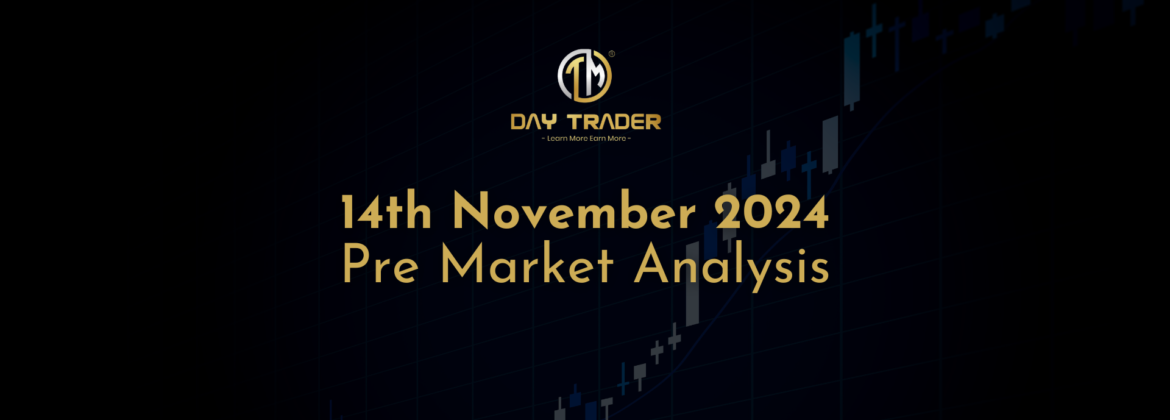Pre-market analysis of global and Indian market indices as of November 14, 2024, highlighting mixed performances in major markets, ongoing declines in Indian equities, and significant movements in stocks based on futures open interest.
Key economic indicators such as US inflation rates and bond yields point toward potential Federal Reserve rate cuts, influencing market sentiments. Additionally, the analysis includes notable bullish and bearish stocks, sector performance, and upcoming earnings releases, offering insights for traders and investors.
Key Points
- GIFT Nifty opened flat, indicating a muted start for Indian markets, while the NSE Nifty 50 and BSE Sensex continued their decline for the fifth consecutive session.
- Asian equities showed slight gains due to US inflation data enhancing expectations for an upcoming Federal Reserve rate cut.
- The Nifty 50 exhibited a long bearish candlestick, indicating a continuing downtrend with above-average trading volumes and an oversold RSI of 30.
- Notable bullish stocks include Tata Power, Deepak Nitrite, and Varun Beverages, each demonstrating significant operational developments or financial performance.
- Major bearish stocks to watch include those reporting earnings today, with notable declines in profits for PNC Infra reported.
- Foreign Institutional Investors (FIIs) were net sellers in the cash segment, while Domestic Institutional Investors (DIIs) were net buyers on November 13, 2024.
- The Put Call Ratio (PCR) analysis showed mixed signals, with a greater bearish sentiment as the PCR for Nifty dropped below 1.

Key Concepts Analysis
- Pre-Market Analysis: This section provides a snapshot of essential global market indices and their performance as of the early morning hours on November 14, 2024. It portrays the opening and closing values of major stock indices like GIFT Nifty, Dow Jones, and Nasdaq, helping traders gauge market conditions before the official trading sessions begin.
- Market Indices: The document outlines various global and Indian market indices, including GIFT Nifty, Dow Jones, Nasdaq, and BSE Sensex. These indices serve as indicators of the market’s performance, indicating trends and conditions in the stock market. For instance, movements in these indices can reflect investor sentiment and economic outlook.
- Long/Short Build-Up Stocks: This segment identifies stocks experiencing significant increases or decreases in open interest, signifying potential bullish or bearish trends. Long build-up stocks indicate growing investor confidence, while short build-up stocks signal increasing bearish sentiment, crucial for traders devising their market strategies.
- Sector-wise Analysis: The document highlights top-performing sectors within the NSE based on their performance over the previous week. Understanding which sectors are performing well provides insights into market health and potential investment opportunities.
- Technical Analysis: The document examines the market’s technical indicators, particularly for the Nifty 50. It discusses key levels of support and resistance, trends in trading volume, and signals such as the Relative Strength Index (RSI). This information is vital for traders who analyze these indicators to make informed trading decisions.
- Market News : This section provides context regarding market movements, including news on inflation data, Federal Reserve rate cut expectations, and Asian currency trends. Such news can significantly influence trading strategies and market sentiment.
- Put Call Ratio (PCR) : The PCR is discussed as a critical tool in options trading that gauges market sentiment. A ratio above 1 indicates bullish sentiment, while below 1 implies bearish sentiment. Understanding the PCR helps traders assess market psychology and adjust their strategies accordingly.

Related Questions
- What are the implications of US inflation data on global market trends?
- How do changes in foreign and domestic institutional investments affect market performance?
- What factors contribute to the bullish and bearish trends in specific stocks?


Leave A Comment